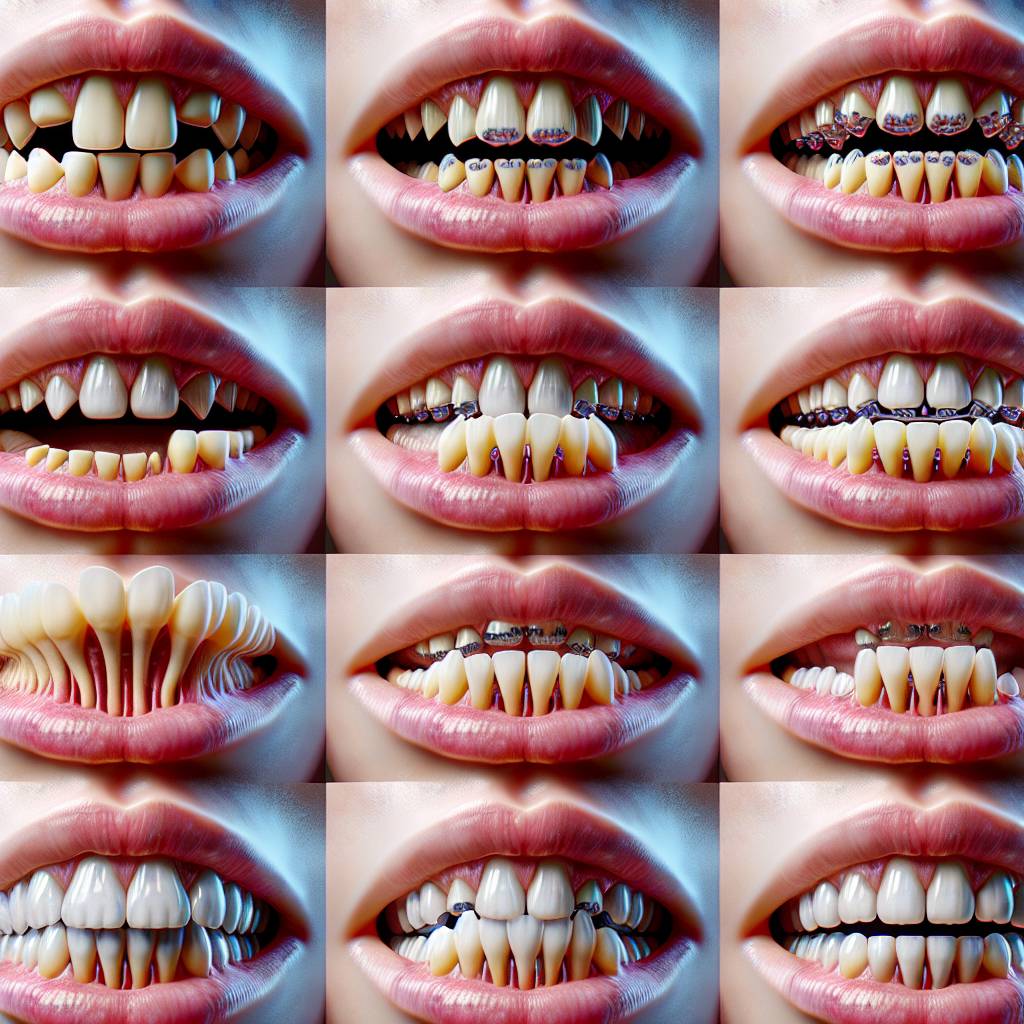Gaps in teeth can be unsightly and can cause people to feel self-conscious about their smile. These gaps can form for a variety of reasons, ranging from genetics to poor oral hygiene. In this article, we will discuss how gaps form in teeth and the treatments available to close them.Gaps between one or more of the teeth can be caused by a variety of factors including genetics, tooth loss, thumb sucking, and improper dental hygiene. In some cases, congenital defects can also cause gaps in teeth. Teeth grinding or clenching may also cause gaps to form between the teeth. Additionally, misalignment of the jaw and certain medical conditions can contribute to gaps in the teeth.
Congenital Abnormalities
Gaps between teeth can be due to congenital abnormalities. This is a condition present at birth, which may cause the teeth to be abnormally shaped, or missing altogether. In some cases, the size of the jaw may be too small or too large in comparison to the size of the teeth which can also lead to gaps between them. It is important to note that congenital abnormalities are not inherited, but are caused by external factors such as nutrition during pregnancy or genetics.
Dental Trauma
Dental trauma is another common cause of gaps between teeth. This kind of trauma is usually caused by an accident or injury that affects one or more teeth. In some cases, it can result in a tooth being knocked out completely, while in others it may result in a fracture or chip that causes a gap between two teeth. Dental trauma can also cause misalignment of the teeth and jaw, which can create gaps when the remaining teeth move into their new positions.
Periodontal Disease
Periodontal disease is an infection in the tissues surrounding and supporting your teeth which can lead to gum recession and bone loss. This infection can cause gaps between your teeth due to the destruction of the tissue that holds them in place. If left untreated, periodontal disease can worsen over time and will eventually lead to tooth loss.
Tooth Erosion
Tooth erosion is another common cause of gaps between your teeth and is caused by acids eating away at tooth enamel. This could be due to excessive consumption of acidic foods and drinks such as soda or citrus fruits, as well as from certain medical conditions that increase acidity levels in saliva. Tooth erosion can also occur due to frequent vomiting associated with conditions like bulimia.
Malocclusion
Malocclusion is a condition where your upper and lower jaws do not align properly, causing misalignment of your bite and other related problems such as gaps between your teeth. Malocclusion usually occurs during development through childhood but can also be caused later on by factors such as dental trauma or tooth loss due to periodontal disease
What Factors Contribute to the Formation of Gaps in Teeth?
Gaps between teeth, known as diastema, can be caused by a number of factors. In some cases, genetics may play a role in the formation of gaps between teeth. If one or both parents have gaps between their teeth, it is likely that their children will have them too. In other cases, the gap may be due to an uneven jaw structure. If the upper jaw is larger than the lower jaw, this can cause a gap to form in between teeth. Other factors that can contribute to the formation of gaps are misaligned teeth and missing teeth. When teeth are misaligned, it can create empty space between them which leads to a gap. Additionally, when a tooth is missing, the surrounding teeth may drift into the empty space and cause an unwanted gap.
In some cases, gaps are formed due to poor dental hygiene habits. When plaque builds up on the teeth and gums it can lead to gum recession which can create gaps in between the teeth. Poor oral health habits such as not brushing and flossing regularly or using tobacco products can also lead to gum recession and gapping of the teeth.
Gaps between your teeth do not always need to be corrected with orthodontic treatment. Some people prefer their diastema as part of their unique smile and choose not to close it with braces or other treatments. However, if you would like to correct your gaps there are several options available such as braces or bonding which can help close up any unwanted spaces in between your teeth.
Diastema
Diastema is a gap between two teeth that is usually caused by over-retained primary teeth, unequal sizes of teeth, or a lack of teeth in the dental arch. This type of gap is usually seen between the front two upper teeth or the lower incisors. Diastema can occur in both children and adults. It can be treated with orthodontics or dental bonding, depending on the severity of the case.
Missing Teeth Gaps
Missing teeth gaps are caused by tooth loss due to injury, periodontal disease, or other factors. These gaps can cause difficulty with eating and speaking and may cause an uneven bite if not corrected. Missing teeth gaps can be corrected through orthodontic treatment, dental implants, bridges, or partial dentures.
Open Bite Gaps
Open bite gaps occur when one or more of the back molars do not meet properly when biting down. This type of gap can be caused by tongue thrusting, finger sucking, incorrect jaw development, misaligned jaw joints, or trauma to the jawbone. Treatment for an open bite gap typically involves orthodontic treatment to realign the teeth and jaw into proper position.
Overbite Gaps
An overbite gap occurs when one’s upper front teeth overlap their lower front teeth more than normal when biting down. This type of gap may be caused by incorrect jaw joint alignment or genetics and typically requires orthodontic treatment to correct it. Braces are usually used to move the upper front teeth back slightly so that they no longer overlap the lower front teeth.
Midline Diastema
A midline diastema occurs when there is a large space between the two upper central incisors (front two top teeth). This type of gap is typically caused by genetics but can be exacerbated by thumb-sucking habits in children. Midline diastemas are usually treated with braces or clear aligners to close the gap between the central incisors and create a more symmetrical smile.
Poor Oral Hygiene Can Lead to Gaps in Teeth
Poor oral hygiene can lead to gaps in teeth, which can have a negative impact on your overall dental health. Poor oral hygiene is defined as not brushing your teeth twice a day, not flossing daily, and not using a mouth rinse at least once a day. Plaque buildup and bacteria accumulate on the teeth when you don’t practice good oral hygiene habits. This will eventually lead to cavities, gum disease, and other dental issues.
Gaps in teeth can occur when plaque and bacteria are allowed to build up. The bacteria cause acids that weaken the enamel of the teeth, leading to decay. When this happens, it can cause gaps between the teeth where they were once held together by the enamel. Gaps in teeth can also be caused by grinding or clenching your teeth. This puts unnecessary pressure on the teeth which can lead to them shifting and creating gaps between them.
Gaps in teeth can affect your overall dental health negatively because it makes it more difficult for you to clean those areas of your mouth properly, meaning that plaque and bacteria will accumulate even more quickly in those spots. This increases your risk of developing cavities or gum disease, which can have serious consequences for your oral health if left untreated. Additionally, gaps in teeth can also lead to an increased risk of injury if something sharp gets stuck between them.
It is important to practice good oral hygiene habits such as brushing twice a day and flossing daily in order to prevent gaps from forming between your teeth. If you already have gaps in your teeth, talk to your dentist about treatment options such as braces or veneers that can help close them up again. Taking care of your oral health now will help ensure that you don’t have any issues with gaps down the line.

The Impact of Genetics on Gaps in Teeth
Gaps in teeth are a common dental issue that can be caused by genetics. Genetics can play a role in the size and shape of teeth, as well as the amount of space between them. In some cases, the size and shape of the jawbone can also contribute to gaps in teeth. Genetic factors such as these can cause gaps to form between teeth, even when there is adequate space for them to fit together normally. It is important for people to be aware of how their genetics may affect their dental health, so they can seek proper treatment for any conditions that arise as a result.
In general, gaps between teeth are caused by an imbalance in the size or shape of the jaws and teeth. This imbalance can occur due to genetic factors or it can occur due to environmental factors such as poor nutrition or tooth decay. When genetic factors are involved, it is likely that several members of the same family will have similar gaps in their teeth.
Gaps between teeth can affect a person’s appearance and make it difficult for them to properly clean their mouth. They may also lead to problems with pronouncing certain words or making certain sounds correctly. To address these issues, braces and other orthodontic treatments may be necessary. Braces work by gradually shifting the position of the teeth and jawbone over time, allowing them to fit together more properly without creating gaps between them.
In some cases, surgery may be necessary to correct severe gaps in teeth that cannot be addressed with braces alone. Surgery may involve reshaping portions of the jawbone or using fillers and implants to fill in spaces between teeth. However, surgery is typically only recommended when other methods have failed or if there is an underlying medical condition causing the gap in teeth.
It is important for people who are concerned about gaps in their teeth due to genetics to seek advice from their dentist or orthodontist about treatment options available for them. With proper treatment, it is possible for people with genetic-related gaps in their teeth to improve both their appearance and oral health over time.
Habits Like Thumb Sucking and Tongue Thrusting Can Result In Gaps in Teeth
Thumb sucking and tongue thrusting are two of the most common oral habits in children. While these habits may seem harmless, they can have lasting consequences on the teeth and bite of a child. Over time, these habits can lead to gaps in the teeth, which are known as diastemas.
When it comes to thumb sucking, this habit can cause the front teeth to move outward and become more prominent. This is because the thumb pushes against the front teeth when it is sucked and causes them to be pushed outward. The longer a child sucks their thumb, the more space there will be between the upper and lower front teeth.
Tongue thrusting is another habit that can cause gaps in the teeth as well. When a person thrusts their tongue forward while swallowing or speaking, it can cause their top and bottom teeth to separate from each other. This happens because the tongue is pushing against the back of the top teeth and pushing them away from the bottom ones. The longer this habit persists, the more space will form between these two sets of teeth.
Fortunately, both these habits can be corrected with orthodontic treatment such as braces or Invisalign aligners. Treatment will help realign both sets of teeth so that they meet properly at all times. In addition, orthodontists may also recommend wearing retainers after treatment to ensure that any gaps do not return after treatment is complete.
It’s important for parents to recognize when their children are engaging in these oral habits so that they can take steps to correct them before any damage is done to their child’s smile. By taking early action, parents can help keep their child’s teeth healthy for years to come!
The Role of Dental Trauma in the Formation of Gaps Between Teeth
Dental trauma is an important factor to consider when looking at gaps between teeth. Trauma to the teeth can cause fractures, chips, and other damage that can lead to gaps forming between them. In some cases, trauma can also cause the teeth to become misaligned and create a gap. It is important to note that not all dental trauma will result in a gap between teeth; however, it can be a contributing factor.
Traumatic injuries can occur from falls, sports injuries, car accidents, or even during regular activities like chewing. When the force of the impact is significant enough, it can cause damage to the enamel or underlying structures of the tooth, leading to a gap forming between them. The type of tooth damage that occurs due to trauma will depend on how severe the impact was and which teeth were affected.
In some cases, gaps may form due to dental trauma but may not be immediately visible. When this happens, a patient may need further evaluation by their dentist in order to determine if there is any underlying damage that could be causing the gap. Additionally, if there is already a pre-existing gap between two teeth due to genetics or environmental factors such as poor oral hygiene habits, then dental trauma could potentially worsen this condition by causing further damage.
It is important for patients who have experienced dental trauma or have gaps in their smile due to past trauma to seek treatment from their dentist as soon as possible so that any further damage can be prevented and treated appropriately. Early intervention can help minimize any potential complications and ensure proper healing of the affected area. With prompt treatment and good oral hygiene habits, patients should expect healthy smiles for years to come!

Conclusion
Gaps in teeth can form for a variety of reasons. Poor oral hygiene, gum disease, genetics, and trauma are some of the most common causes. It’s important to practice good oral hygiene and visit your dentist regularly to minimize the risk of developing gaps in your teeth. If you do develop gaps, there are a variety of treatment options available depending on the cause and severity. Talk to your dentist to determine the best course of action for you.
Taking care of your teeth is critical for overall health and wellbeing. Gaps in teeth can have long-term consequences if left untreated, so it is important to pay attention to any changes or new symptoms. With proper care and regular visits to the dentist, you can keep your teeth healthy and strong for years to come.

